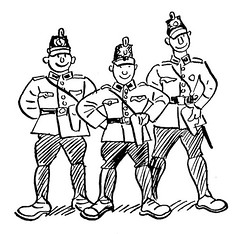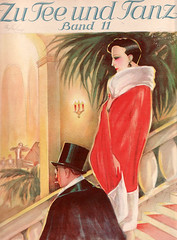Showing posts with label berlin. Show all posts
Showing posts with label berlin. Show all posts
2009/01/15
2008/11/22
2008/10/22
Berlin & Paris
***
Berlin: Die Sinfonie der Großstadt, 1927 (see DrMabuseDerSpieler for more)
A rather more conservative travel film of Paris in the 1920's (part 2; see travelfilmarchive for more).
I've been to Paris once; to Berlin, at least 5 times. Some people claim that you have to choose between France and Germany, you can't keep both (as lovers??), but it would be lovely if Paris could give me a chance again. I'm sure Berlin won't mind, she loves Paris, too.
***
Berlin: Die Sinfonie der Großstadt, 1927 (see DrMabuseDerSpieler for more)
A rather more conservative travel film of Paris in the 1920's (part 2; see travelfilmarchive for more).
I've been to Paris once; to Berlin, at least 5 times. Some people claim that you have to choose between France and Germany, you can't keep both (as lovers??), but it would be lovely if Paris could give me a chance again. I'm sure Berlin won't mind, she loves Paris, too.
***
2008/07/06
Berliner Polizisten
Berlin cops, 1930's style. I love this uniform!
By Walter Trier, from the children's book Pünktchen und Anton by Erich Kästner.
2008/05/19
Alfred Abel

I first encountered him in Metropolis (1926, good article at cyranos.ch). Abel played the future industrialist Joh. Fredersen, father of the young hero, who orders the creation of an artificial woman in order to provoke the oppressed workers into a fatal uprising. (I've always wondered why the robot woman is supposed to subvert the peaceful preaching of Maria, although the real Maria keeps the workers lulled in a state of passive hope, most useful to the rulers.)
Abel's gaunt look was very impressive, and his acting was wonderfully tactful (compared to the rest of the cast). Turns out that he was rather cute in real life, although the eyebrows were part of the mask. Behold:
 What a striking difference!
What a striking difference! Abel (1879–1937) was not only a successful and well liked actor in film and theatre (as early as 1914, he had performed in every theatre in Berlin), he was also a director and producer. His first film part was under the direction of theatre wizard Max Reinhardt (I found a book about him in Berlin last December). Besides Fritz Lang (Dr. Mabuse, Metropolis) he also worked with F. W. Murnau and Ernst Lubitsch - names that really should make your modern little hearts beat faster. Interestingly, he began his career by studying gardening and artistic drawing... and his own production company was called Artifex Film (something interesting for my mother!). He also had a well-kept wardrobe:
Abel (1879–1937) was not only a successful and well liked actor in film and theatre (as early as 1914, he had performed in every theatre in Berlin), he was also a director and producer. His first film part was under the direction of theatre wizard Max Reinhardt (I found a book about him in Berlin last December). Besides Fritz Lang (Dr. Mabuse, Metropolis) he also worked with F. W. Murnau and Ernst Lubitsch - names that really should make your modern little hearts beat faster. Interestingly, he began his career by studying gardening and artistic drawing... and his own production company was called Artifex Film (something interesting for my mother!). He also had a well-kept wardrobe: As usual in this blog, he died far too young, after a longer illness in 1937. He just escaped the claws of the Third Reich; his daughter Ursula, who was also pursuing a career in acting, could not produce proof that he was "Aryan", and she had to give up her dream. Without the proper pedigree, an actor was not accepted. Abel's father was a peddler, Louis Abel, married to Anna Maria Selma in Leipzig. Their names and trades would make them suspicious in the eyes of later generations. All clues pointed to a Jewish origin.
As usual in this blog, he died far too young, after a longer illness in 1937. He just escaped the claws of the Third Reich; his daughter Ursula, who was also pursuing a career in acting, could not produce proof that he was "Aryan", and she had to give up her dream. Without the proper pedigree, an actor was not accepted. Abel's father was a peddler, Louis Abel, married to Anna Maria Selma in Leipzig. Their names and trades would make them suspicious in the eyes of later generations. All clues pointed to a Jewish origin.
Sources: Wikipedia
Filmportal.de
film.virtual-history.com
I suppose that accusation was a sign of posthumous anti-Chirayliqism (as experienced by certain Russian actors, who, being too handsome, were accused of belonging to various politically incorrect ethnicities).
2008/05/17
Zu Tee und Tanz
I found this amazing Weimar era music album in a local second hand book store. It's a potpourri of fox trots, tangos, schlagers and operetta hits.
"Wann kommst Du zu mir?"
Text von Karl Farkas; Melodie von Franz Steininger. 1927
Wo ist die Frau, die heutzutag'
dem Andrang wehren kann?
Sieht sie nur halbwegs aus,
sieht sie ein jeder an.
Der Smoking-Dandy wandelt sich
zum Liebesseladon
und macht ihr gleich die Proposition:
Wann kommst Du zu mir?
Wann kommt die Stunde, die uns vereint?
Ich sehn' mich nach Dir,
wenn Nachts der Mond in mein Zimmer scheint!
Die wahre Licht, die uns selig macht,
wird durch die Nacht erst an den Tag gebracht.
Kommst heut Du zu mir,
dann bleibst Du sicher bis morgen hier!
Wann ...
Man denkt natürlich nicht daran, daran zu denken je,
und sagt dem Rendezvous im vorhinein ade.
Doch andern Tages kommt ein Briefchen rosa oder blau,
und drin steht: "Hochverehrte, gnäd'ge Frau!
Wann ...
"Wann kommst Du zu mir?"
Text von Karl Farkas; Melodie von Franz Steininger. 1927
Wo ist die Frau, die heutzutag'
dem Andrang wehren kann?
Sieht sie nur halbwegs aus,
sieht sie ein jeder an.
Der Smoking-Dandy wandelt sich
zum Liebesseladon
und macht ihr gleich die Proposition:
Wann kommst Du zu mir?
Wann kommt die Stunde, die uns vereint?
Ich sehn' mich nach Dir,
wenn Nachts der Mond in mein Zimmer scheint!
Die wahre Licht, die uns selig macht,
wird durch die Nacht erst an den Tag gebracht.
Kommst heut Du zu mir,
dann bleibst Du sicher bis morgen hier!
Wann ...
Man denkt natürlich nicht daran, daran zu denken je,
und sagt dem Rendezvous im vorhinein ade.
Doch andern Tages kommt ein Briefchen rosa oder blau,
und drin steht: "Hochverehrte, gnäd'ge Frau!
Wann ...
2008/04/16
Walter Trier

Erich Kästner's books from the 20's and 30's have lovely illustrations. We got some of them (Emil und die Detektive, for example) from our dear old neighbour, Herr Dr. Rosenplänter, when we lived in Germany.
The illustrator was Walter Trier. He had to flee Germany with his family in 1936, because he was Jewish. I think I have a crush on him (he looks a little like Falco).
Trier was a prominent illustrator, but he also provided caricatures and cartoons for Simplicissimus, covers for the British magazine Lilliput, Allied propaganda flyers to be thrown over Germany during the war. He was offered work by Disney, but refused - he wanted to work under his own name. Shortly after emigrating to Canada, he died in his atelier 1951.
Some pictures:
A map of Europe in WW1
German boxer Max Schmeling
Hermann Göring paper doll "for the young"
Covers for Lilliput magazine (always with a man, a woman and a dog)
Some of Kästner's and Trier's books
Erich Kästner was forbidden from publishing in 1933, and his books were publicly burnt. He was hounded by the Gestapo, but he continued to write and publish his works in Switzerland, and he travelled to meet Trier in Austria in the 1930's. In 1943, he was no longer allowed to write, either. After the war, Kästner dealt with his experiences in pacifist books for children and adults. He continued to work together with his friend Trier.
You can follow Emil and the detectives' path through Berlin of 1929 in photos, drawings and maps here.
Subscribe to:
Posts (Atom)


